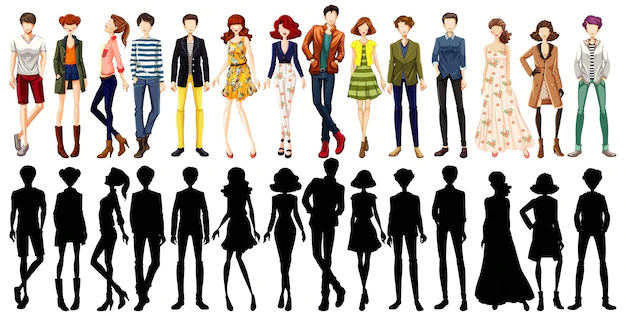Selecting the Optimal Swimsuit: A Comprehensive Guide for Diverse Body Types
The selection of swimwear significantly impacts an individual's comfort and self-assuredness during summer activities. This guide offers a structured approach to swimsuit selection, incorporating principles of body image perception, visual communication, and apparel ergonomics to assist individuals in choosing flattering and comfortable swimwear. Key concepts to be addressed include body shape typology, visual perception principles (color theory and pattern application), and principles of apparel fit and comfort.
Body Shape Analysis and Swimsuit Selection: A Synergistic Approach
Understanding one's body type—commonly categorized as hourglass, pear, apple, rectangle, or inverted triangle—is fundamental to effective swimsuit selection. This categorization, based on the distribution of body mass and proportions, guides the choice of styles that either accentuate desirable features or subtly minimize perceived areas of concern. This process aligns with the principles of body image perception and the application of apparel to achieve a balanced visual presentation. For example, individuals with an hourglass figure might benefit from styles that emphasize the waistline, while those with a pear shape may find high-waisted bottoms more flattering.
Strategic Use of Visual Elements: Color, Pattern, and Silhouette
Color and pattern play a crucial role in shaping visual perception. Darker colors, as per color theory, tend to create a slimming effect by minimizing visual bulk, whereas brighter colors and bold patterns draw attention. Understanding these principles allows for strategic manipulation of the perceived body shape. Vertical stripes, for instance, elongate the body, while horizontal stripes can create the illusion of wider hips. Additionally, the silhouette of the swimsuit itself—high-waisted, one-shoulder, or those incorporating strategic ruching—can subtly contour and reshape the visual perception of the body.
Prioritizing Comfort and Support: Apparel Ergonomics in Swimwear
Comfort and support are paramount considerations. From an ergonomic perspective, a well-fitting swimsuit avoids pressure points and restricts movement minimally, ensuring comfort throughout use. For individuals with larger busts, swimsuits with underwire, adjustable straps, or built-in cups provide the necessary support. Choosing a swimsuit that offers adequate support and does not restrict movement aligns with principles of apparel ergonomics, maximizing comfort and preventing discomfort. The fit of the garment should be prioritized above stylistic choices to guarantee optimal comfort and body image satisfaction.
Swimsuit Styles and Their Impact on Body Shape Perception
A wide variety of swimsuit styles cater to different body types and preferences. One-piece swimsuits offer versatility and coverage, with various designs such as cutouts or high-cut legs to create visually flattering silhouettes. High-waisted bottoms provide tummy control and a retro aesthetic. One-shoulder styles draw attention to the neckline and shoulders, diverting attention away from other body areas. Swim dresses offer more coverage and a polished look, enhancing body image perception. The strategic pairing of swimsuits with sarongs or cover-ups provides additional coverage and style.
Customization and Fit: Tailoring Swimwear to Individual Needs
The option to purchase separates allows for a customized fit to accommodate variations in upper and lower body proportions. This flexibility ensures a personalized fit and emphasizes the importance of proper sizing for maximum comfort and a flattering appearance. This aspect underscores the significance of individualized apparel selection, deviating from the one-size-fits-all approach.
The Crucial Role of Fit and Trial: Ensuring Optimal Apparel Selection
Trying on swimwear before purchase is essential to guarantee an optimal fit. Variation exists between brands and styles, highlighting the importance of physically assessing the garment before purchase. This step allows for a personalized evaluation of fit, comfort, and overall appeal, minimizing the chances of buyer's remorse and maximizing satisfaction.
Confidence: The Ultimate Swimsuit Accessory
Confidence is the most crucial factor in selecting and wearing a swimsuit. Self-acceptance and a positive body image foster a confident demeanor, which transcends stylistic choices. Ultimately, the most flattering swimsuit is one that makes the individual feel self-assured and comfortable.
Conclusion and Recommendations
In conclusion, selecting the optimal swimsuit involves a multifaceted process encompassing body shape analysis, strategic application of color and pattern, attention to comfort and support, and a thoughtful consideration of various styles. By understanding and applying the principles of visual perception, apparel ergonomics, and body image perception, individuals can make informed choices that enhance both their comfort and confidence. Further research could explore the impact of different swimsuit fabrics and construction techniques on comfort and support, as well as the development of more inclusive sizing systems. The recommendations include educating consumers about body shape typology, visual perception principles, and apparel ergonomics to empower them to make informed decisions. The impact of this knowledge is a boost to consumer confidence and improved body image perception, leading to increased satisfaction with swimwear choices. The applicability extends to other clothing categories, fostering more informed purchasing decisions across a wider spectrum of apparel.
Reader Pool: Considering the principles outlined in this article, how might the swimwear industry better address the needs and preferences of diverse body types to foster greater body positivity and consumer satisfaction?




No comments yet. Be the first to share your thoughts!